Editor of this issue: Kęstutis Girnius
Copyright © 1978 LITUANUS Foundation, Inc.

|
LITUANUS
LITHUANIAN QUARTERLY JOURNAL OF ARTS AND SCIENCES
Volume 24, No.3 - Fall 1978
Editor of this issue: Kęstutis Girnius ISSN 0024-5089
Copyright © 1978 LITUANUS Foundation, Inc. |

|
CAUSATIVE CONSTRUCTION IN LITHUANIAN
CHIEN-CHING MO
National Chengchi University
O. INTRODUCTION.
Generally speaking, defining the causative construction is no easy task 1. Due to the fact that a syntactic structure that conveys a causative expression varies from one language to another, the easiest way to define the causative construction is, perhaps, by characterizing the 'causative situation'. Shibatani (1976:239) assumes that two events can be said to constitute a causative situation if the following two conditions hold:
a. The relation between the two events is such that the speaker believes that the occurrence of one event, the 'caused event', has been realized at t2, which is after tl, the time of the 'causing event'.
b. The relation between the causing and the caused events is such that the speaker believes that the occurrence of the caused event is wholly dependent on the occurrence of the causing event; the dependency of the two events must be to the extent that it allows the speaker to entertain a counter-factual inference that the caused event would not have taken place at that particular time if the causing event had not taken place at that particular time if the causing event had not taken place, provided that all else had remained the same.
The objectives of this paper are: (1) to argue that the Causative case as proposed by case grammarians like Langendoen (1970), and Babcock (1972) is not a prepositional case, and (2) to demonstrate that on the basis of Shibatani's causative situation, Lithuanian causatives can be illustrated within the framework of case grammar.
1. The Causative Case h Not a Prepositional Case.
Shibatani (1976:240) mentions:
English causatives are of two types, one with auxiliary causative verbs such as cause, make, etc., and the other with morphologically irregular causative verbs, e.g. open, melt.
For example,
(1) Fear made John tremble.
'*Baimė padarė Joną drebėti.'
(2) John trembled with fear.
'Jonas drebėjo iš baimės.'
Babcock (1972:30) assumes that the description of sentences (l)-(2); to wit, (1) is an alternant of (2), requires the introduction of the category of 'Cause' (=Causative in this paper) into the case framework and diagrams the derivation of (1) and (2) as follows:
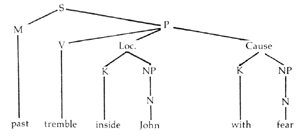
In Cook (1972:45), it is pointed out that prepositional cases are noun-verb relations. They fill in the central characters which surround the main verbal action. Modal cases tend to be verb-adverb relations with the modal cases filling in the details of time, place, and circumstance which surround the action of the principal characters." Note that the corresponding Lithuanian sentence of (1) is ill-formed. However, it seems clear that with fear 'iš baimės' in (2) is in the adjunct position and serves as an optional adverbial of cause in English and Lithuanian. This means that it is not related to the proposition but to the modality of the sentence as a whole. Below are some other examples given by Babcock (1972):
(3) Hunger made John faint.
"Badas padarė Joną apalpti.'
(4) John fainted from hunger.
'Jonas apalpo nuo bado.'
(5) The news saddened John.
'Žinia nuliūdino Joną.'
(6) John was sad because of the news.
'Jonas nuliūdo dėl žinios.'
From 'nuo' in (4) and because of 'dėl' in (6), similar to with 'iš' in (2), are modal case markers indicating adverbials of cause in English and Lithuanian.
Langendoen (1970:73) suggests that any instrument-like expression, when used in a sentence without a conceivable Agent, is to be taken to designate a Cause rather than Instrument and gives the following as an example of what he terms Cause:
(7) Water rotted the timbers.
'Vanduo supūdė medį.'
but:
(8) *Someone rotted the timbers with water.
'*Kas nors supūdė medį vandeniu.'
Inanimate nouns such as water have their own internal powers to perform an action without an external instigator. To explain these occurrences, Chafe (1970:109) introduces a feature, Potent, which corresponds to Force in Huddleston (1970) and Cause in Langendoen (1970). Consider the sentences with inanimate subjects as follows:
(9) The key opened the door.
Raktas atidarė duris.'
(10) The flood drowned the village.
'Potvynis užliejo kaimą.'
We assume that inanimate subjects of action-process verbs 2 are of two kinds: in one, the nouns may assume the role of Instrument in a prepositional phrase, and in the other, no such syntactic connection is available. (9) represents the first kind and (10) the second kind. It is evident that (9) implies some unexpressed animate Agent, that is, key is unable to carry out the intended function without an Agent. Therefore, key should be termed as Instrument in (9) and (11).
(11) Someone opened the door with the key.
'Kažkas atidarė duris raktu.'
However, water and flood possess potency for certain phenomena without an Agent, and therefore they can not serve as Instruments, as in (8) and (12).
(12) "Someone drowned the village with the flood.
'*Kažkas užliejo kaime potvyniu.'
Besides, animate Agentive nouns and the subjects in (7) and (10) may undergo passivization but (9) may not.
(13) *The door was opened by the key.At present, we can reach a definite conclusion that a potent noun, like an animate noun, has the same syntactic behavior; to wit, both can undergo subjectivization and passivization. To capture this aspect, we follow Chafe (1970) and define the Agentive case as the instigator or the motivating force of an action. This case must be manifested by either animate or potent Agentive nouns. Thus, we term water in (7} and flood in (10) as the Agentive rather than the Causative. Finally, from the above discussion, we know that the Causative case proposed by Babcock (1972) is one of the modal cases; the Causative case as suggested by Langendoen (1970), though a prepositional case, is in essence an Agent.
2. Lithuanian Causafives
Lithuanian causatives may be roughly classified into two types on the basis of morphological regularity. The regular type involves the infix-in-, which inserts between the verb stem and the infinitive marker - ti.
In the following pair of sentences,
(16) a. Ūkininkas augina bulves.
The farmer grows potatoes.'
b. Ūkininkas valgo bulves.
The farmer eats potatoes.'
Ūkininkas 'farmer' in both sentences functions as the Agentive noun of an action-process verb but the verbal processes involved are quite different. The fact that (16.a) may be paraphrasable as in (17.a) but (16.b) may not as in (17.b)
(17) a. Ūkininkas taip padaro, kad bulvės auga.
The farmer brings it about that potatoes grow'
b. 'Ūkininkas taip padaro, kad bulvės valgo.
"The farmer brings it about that potatoes eat.'
suggests that auginti 'grow' may occur without an Agent whereas valgyti 'eat' may not, e.g.
(18) a. Bulvės auga. b. "Bulvės valgo.
'Potatoes grow.' '*Potatoes eat.'
This means that auginti is derived by the addition of the causative infix-in-to the intrinsic process verb stem aug-. In this sense, (16.a) but not (16.b) is a causative sentence. Thus, we can point out the difference by different verb features; auginti is a derived action-process verb while valgyti is an intrinsic one. Under this analysis, the deep structure of (16.a) and (16.b) would look something like (19.a) and (19.b) respectively.
(19) a.
V
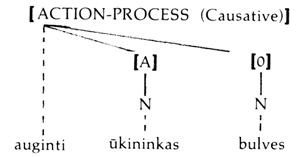
(19) b.
V
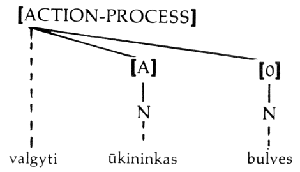
Other examples are given below:
(20) a. Jonas tirpino stiklą.
'John melted the glass.'
b. Stiklas tirpo.
'The glass melted.'
(21) a. Jonas sugrąžino bilietą.
'John returned the ticket.'
b. Bilietas sugrįžo.
'The ticket returned.'
(Derived action-process verb)
(Process verb)
(Derived action-process verb)
(Process verb)
In addition, many action-process verbs are derivationally related to state verbs. That is, an action-process verb can be derived by the addition of the causative unit to the stem of an inchoatively derived process verb, as (22.a) exemplifies. {22.a) is derivationally related to {22.b) and (22.c).
(22) a. Jonas pailgino man kelnes.
'John lengthened my pants.'
b. Mano kelnės pailgėjo.
'My pants got longer.'
c. Mano kelnės yra ilgos.
'My pants are long.'
Other examples are:
(23) a. Jonas baltino savo dantis.
'John whitened his teeth.'
b. Jono dantys balo.
'John's teeth whitened.'
c. Jono dantys yra balti,
'John's teeth are white.'
(24) a. Karas sumažino mūsų pajamas.
The war diminished our income.'
b. Mūsų pajamos sumažėjo dėl karo.
'Our income diminished on account of the war.'
c. Mūsų pajamos yra mažos.
'Our income is small.'
The deep structure of (22.a) can be diagramed as follows:
V
[ACTION-PROCESS (CAUSATIVE+INCHOATIVE]
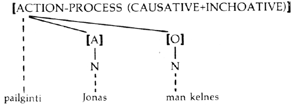
Notice that Lithuanian causatives having the same morphological shape as their derivatives are infrequent 3 . Two examples are seen in the following pairs of sentences:
(25) a. Mama kepa pyragus.
'Mother bakes cakes.'
b. Pyragai kepa.
The cakes bake.'
(26) a. Jonas verda mėsa.
'John is cooking the meat.'
b. Mėsa verda.
The meat is cooking.'
It should be pointed out that not all Lithuanian causatives are formed by adding -in- to process verbs. The other type of Lithuanian causatives, illustrated in (27) and (28), involves forms which are related to intrinsic action-process verbs. Lithuanian usually resorts to the particle -si- to express the process verb derived by the addition of the deactivative unit to the intrinsic action-process verb 4 .
Examples are:
(27) a. Jonas įtempė virvę.
'John tightened the rope.'
b. Virvė įsitempė.
'The rope tightened.'
(28) a. Jonas uždarė dėžę .'
'John closed the box.'
b. Dėžė užsidarė.
'The box coled.'
(27.a) has either (29) or (30) as a paraphrase.
(29) Jonas darė kažką virvei, ir virvė įsitempė.
'John did something to the rope and the rope tightened.'
(30) Jonas taip padarė, kad virvė įsitempė.
'John brought it about that the rope tightened.'
To represent the deep structure of (27.a), we can draw a dependency tree shown below:
V
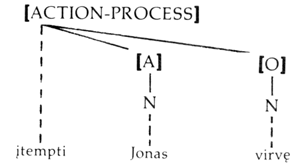
On the other hand, according to my analysis (1977), Lithuanian causatives can be classified into four types in terms of their case frames 5 .
(a) +[__A, O]
A Lithuanian causative verb with this case frame, exemplified as in (31)-(33), indicates some kind of activity that can be performed by someone or some potent force.
(31) Jonas atidarė duris.
'John opened the door.'
(32) Jonas tirpino stiklą.
'John melted the glass.'
(33) Potvynis panardino namą.
The flood caused the house to become submerged.'
Cruse (1972:522) refers to sentences like (31)-(33) and the following (34)-(36) as 'causation by direct physical action' and 'causation by command' respectively.
(34) John galloped the horse around the field.
(35) John worked the men hard.
(36) John marched the prisoners.
This type of causation by command is not exactly expressible in terms of Lithuanian causatives. Albeit Prof. Klimas (personal communication) indicates that these sentences can be loosely translated as in (37), (38) and (39) respectively, this syntactic lacuna seems not to be filled.
(37) Jonas jojo šuoliais apie lauka.
'John rode on horseback at a gallop about field.'
(38) Jonas vertė vyrus sunkiai dirbti.
'John forced men hard work.'
(39) Jonas vedė kalinius.
John led prisoners.' (b) +[0, D]
Fillmore (1971:42) maintains that the whole class of "so-called Psych-Movement verbs... require a transformation which moves the highest ranked non-Experiencer noun phrase into the first position." In other words, the Dative case is chosen as direct object, and a case of lower rank is chosen as subject. This set of psych movement verbs are consequently listed as O-D verbs, and include such verbs as išgąsdinti 'frighten', erzinti 'annoy', nuliūdinti 'sadden', įsiutinti 'infuriate', apstulbinti 'flabbergast'.
Below are some examples:
(40) Dorumas išgąsdina apgaviką.
'Honesty frightens a con man.'
(41) Gandas erzina Marija.
'The rumor annoys Mary.'
(42) Šis dalykas mane labai nuliūdina.
'This matter makes me very sad.'
(c) +[----A, D, O*]/A=O
When the notion of the Agentive is introduced into the psych movement verb, the Agentive becomes the subject of the verb and is coreferential with the Objective case.
(43) Policija išgąsdina apgaviką.
'The police frighten a con man.'
(44) jonas erzino Marija.
'John annoyed Mary.'
(45) Jis mane labai nuliūdina.
'He makes me very sad.'
Cruse (1972:523) terms (43)-45) as 'causation of emotion'. The above examples (40)-{45) show that psych movement verbs like išgąsdinti can co-occur with either animate or inanimate subjects, but they require a direct object which is animate. If the Dative case is chosen as subject, the verb must be in the passive or in the reflexive, as in (46) and (47) respectively.
(46) Apgavikas yra išgąsdinamas dorumo.
'A con man is frightened by honesty,'
(47) Apgavikas lengvai išsigąsta.
'A con man frightens easily.'
Under this analysis, the deep structure of (43) must therefore be something like
V
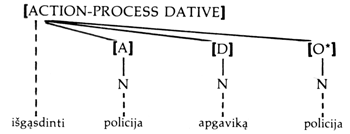
(d) +1-------A, D, O)
Verbs in this case frame are postulated to be causatively related to process dative verbs though they may not be morphologically related (cf. Chafe, 1970:146). For example, consider
(48) a. Jonas parodė gyvate Petrui.
'John showed the snake to Peter.'
b. Jonas taip padarė, kad Petras matė gyvate.
'John caused Peter to see the snake.'
c. Petras mate gyvate.
'Peter saw the snake.'
The verb parodyti 'show' seems to be derivationally related to the process dative verb matyti 'see'. (48.b) is an acceptable paraphrase of (48.a) and is directly related to (48.c). This suggests that A-D-O verbs are causative versions of D-O verbs in which the Dative is subject of the sentence. Below are other examples:
(49) a. Jonas išaiškino Petrui problema.
'John explained the problem to Peter.'
b. Jonas taip padarė, kad Petras suprato problemą.
'John made Peter understand the problem.'
c. Petras suprato problemą.
'Peter understood the problem.'
(50) a. Jonas priminė Petrui atsakyme.
'John reminded Peter of the answer.'
b. Jonas taip padarė, kad Petras atsiminė atsakymą.
'John caused Peter to remember the answer.'
c. Petras atsiminė atsakymą.
'Peter remembered the answer.'
(51) a. Jonas įrodė Petrui pasakos tiesa.
'John convinced Peter of the truth of the fairy story.'
b. Jonas taip padarė, kad Petras tikėjo pasakos tiesa.
'John made Peter believe in the truth of the fairy story.'
c. Petras tikėjo pasakos tiesa.
'Peter believed the truth of the fairy story.'
Assuming that what has been stated above is correct, we then can posit that the underlying structure of (48.a) must be something like
V
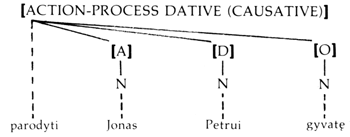
Before ending this paper, 1 would like to point out that perhaps due to the different syntactic or semantic behaviors between English and Lithuanian causativizers, padaryti 'make' in Lithuanian does not play an important role in the causative construction. English verb make is a general verb for cause. Roughly speaking, it can replace almost any causative verb with the following meanings:
(a) to cause to become
(1) The club made him president.
'Klubas išrinko jį pirmininku.'
(2) They made him their leader.
'Jie išsirinko jį savo vadu.'
(b) to cause to behave in a particular manner
(3) Heat makes a gas expand.
'Nuo šilumos dujos plečiasi.'
Lit; From heat gases expand.
(4) Mary made John feel inferior.
'Prieš Mariją Jonas jautėsi menkesnis.'
Lit: Before Mary John felt inferior.
(c) to compel
(5) I made John do his homework.
'Aš priverčiau Joną ruošti pamokas.'
(6) You made him obey.
'Jūs privertėte jį klausyti.'
(d) to cause to acquire a stated property or to be in a psych state
(7) The knife-sharpener made my knife sharp.
'Peilių galąstojas išgalando mano peilį,'
Lit: Knife-sharpener sharpened my knife.
(8) Thank you for making my life in Rochester meaningful and enjoyable.
'Ačiū Jums, kad padarėte mano gyvenime Ročesteryje vertingu ir
maloniu.'
(9) She will make him happy.
'Ji padarys jį laimingu.'
(10) This matter makes people very angry. '
Šis dalykas labai erzina žmones.'
Lit: This matter angers people very much.
Semantically speaking, make in (a) and (c) is very close to Lithuanian išrinkti 'elect' and priversti 'compel, force' respectively. Syntactically speaking, make in (b) is not identical to that in (a) and (c) in Lithuanian causatives. It implies an adverbial phrase indicating the reason why an event or object causes another event. In addition, only make with the meaning of 'compel, force', as in (5) and (6) can undergo passivization in Lithuanian. In (7)-(10) adjectives or participles serve as complements. In case verb forms are available for them, the verb forms with causative meaning are usually used as in (7) and (10). If not, padaryti acts as Lithuanian causativizer as in (8) and (9) similar to make in English. Judging from (1)-(10), except (8) and (9), there seems to be no fixed Lithuanian equivalent for the English causativizer make. There is no doubt that it seems necessary to do further research in this aspect.
BIBLIOGRAPHY
Babcock, Sandra Scharff. 1972. "Paraphrastic Causatives," Foundations of
Language 8:30-43.
Chafe, Wallace L. 1970. Meaning and the structure of Language. Chicago: The
University of Chicago Press.
Cook, Walter A., S.J. 1972. "A Set of Postulates for Case Grammar
Analysis/' Languages and Linguistics: No. 4. 4:35-49.
Cruse, D.A. 1972. "A Note on English Causatives," Linguistic Inquiry, 3(4):520-528.
Fillmore, Charles J. 1968. "The Case for Case," in Universal in Linguistic Theory,
Ed. by Emmon Bach and Robert Harms. New York: Holt, Rinehart and
Winston. 1971. Some Problems for Case Grammar," in
Monograph Series an Languages and Linguistics, No. 24:35-56. Ed. by Richard J.
O'brien, S-J. Washington, D.C. Georgetown University Press,
Huddleston, Rodney. 1970. "Some Remarks on Case Grammar," Linguistic
Inquiry, 1{4);501-511.
Langendoen, D. Terence. 1970. Essentials of English Grammar. New York: Holt,
Rinehart and Winston.
Mo, Chien-ching, 1977. A Case Grammar of Spoken Lithuanian. Ph.D.
dissertation. University of Rochester.
Shibatani, Masayoshi, 1976. "Causativization," in Syntax and Semantics (vol. 5)
Ed. by Masayosho Shibatani. New York: Academic Press, Inc.
Valeika, L. 1975. "Semantic Sentence-Types in Lithuanian and English,"
Kalbotyra xxvj (3):51-63.
1 I am greatly indebted to Professor Antanas Klimas, with whom I have had many invaluable discussions on this and related topics, for his constructive criticisms and constant encouragement. 1 also wish to thank Professors Ronald Harrington and Frances Nyeu for carefully reading an earlier version of this paper and suggesting a number of improvements. Responsibility for inadequacies and errors is, of course, entirely my own.
2 For a thorough discussion of action, process, and state verbs, see Chafe (1970) and Mo (1977).
3 Valeika (1975:56).
4 The derivational processes and the relationships between the derivational units and the verbs which they convert according to Chafe (1970) and Cook (1972) are illustrated as follows:

5 For ease of exposition, the major case categories used in this paper are defined as follows:
The Agentive case (A) required by an Action verb, whether transitive, or intransitive, is used to designate the instigator, or the motivating force of an action. This case must be manifested by either animate or potent Agentive nouns
The Dative case (D) required by a Dative verb is used to designate the animate being that undergoes the change of psychological event of sensation, emotion, or cognition. It must occur with Objective, or Agentive and
Objective cases but not alone.
The Objective case (O) is the semantically most neutral case and the only obligatory case. It is the case of s noun which is affected or unaffected by the action of state identified by the verb or which undergoes a change of state specified in a process verb. It is also the case of a noun which expresses the nominal concept implicit in a verb, or it is created as the result of the action of the verb.